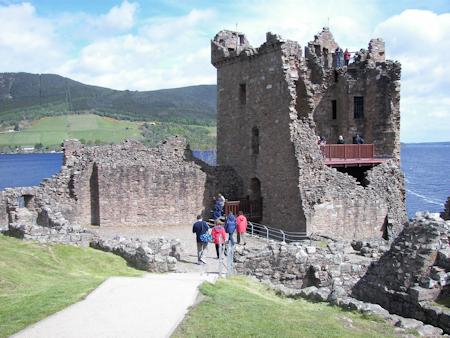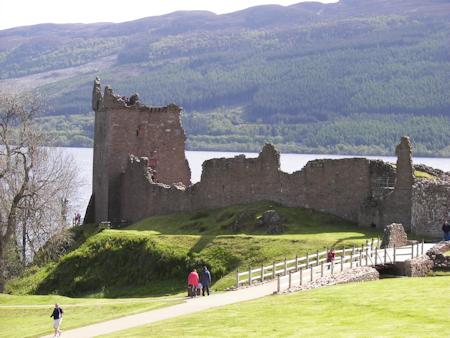
Urquhart Castle
Urquhart Castle sits on a sandstone promontory by the banks of Loch Ness. It was once one of Scotland's largest castles and today it's an impressive and picturesque ruin.
The site of Urquhart Castle has been in use since the Dark Ages. It was a strong and extensive Pictish fort between the 5th and 11th Centuries. There may have been a royal castle on the site in the 12th Century, but no evidence remains of it.
Urquhart's key position allowed it to control traffic along Loch Ness and up into the Great Glen. It was, then a natural target for invaders heading north to Inverness and into the Highlands.
Conflict and Turmoil
Construction of Urquhart Castle began sometime in the early 13th Century. It had come into the possession of Alan Durward, who was one of the most important political figures in Scotland at the time. He built the shell keep around the motte on the south-west corner of the site.
In 1296 Edward I of England captured Urquhart during the Scottish Wars of Independence. His constable, Sir William fitz Warin lost the castle in 1298 after a siege by Sir Andrew de Moray. It changed hands twice more until Robert the Bruce finally took the castle in 1307 during his march through the Great Glen.
After 1307 it was held by a number of constables as a royal castle. In 1342 David II of Scotland became the only king to have stayed here when he used it as a summer hunting lodge.
In the early 15th Century Urquhart Castle was the scene of conflict once more, but instead of English warriors the threat came from much closer to home. The powerful Macdonald Lords of the Isles ruled much of Western Scotland and Urquhart was right on the western border between their territory and the Scottish Kingdom.
They frequently attacked the castle until in 1452 John of Islay, Earl of Ross and Lord of the Isles, finally took Urquhart and held on to it. After four years control passed back to the Crown, but John was granted Urquhart Castle and its lands for life by the king.
The Macdonalds didn't keep the castle for very long. In 1476 John was caught colluding with Edward IV of England against the Scottish Crown. He was stripped of his titles and eventually died in 1503 having lost most of his inheritance.
Urquhart Castle Layout
Given its rough history it's no surprise that Urquhart Castle boasts formidable defences. In terms of area it was one of the largest castles in Scotland.
The whole site is approximately a figure 8 shape enclosed by a 14th Century curtain wall. The approach from the land is defended by a wide dry moat crossed by a stone causeway and drawbridge.
The drawbridge led over to the massive twin-towered gatehouse. Its D-plan towers formed an arched entrance which was protected by a portcullis and guard rooms. Accommodation for the castellan would have been provided over the entrance.
The main tower, Grant Tower, stands in the north-eastern corner. Its foundations date from the 14th Century too, but everything we see today above ground level dates from a 16th Century rebuild. It would have originally been five stories high. The first floor led into a hall with apartments and other accommodation above.
The buildings along the eastern wall of the castle would have held the great hall, the lord's private rooms and solar and the kitchens. A building on a mound within the bailey is thought to have been the chapel.
Later History
In 1509 James IV of Scotland granted Urquhart Castle and its estates to John Grant of Freuchie with instructions to repair and improve it. The Grant family held on to the castle until 1911.
The Lords of the Isles had been destroyed by this time, but the clans of the Western Isles still threatened the castle every time the garrison was weakened.
After the Battle of Flodden in 1513 Sir Donald MacDonald of Lochalsh took advantage of the chaos in Scotland to declare himself Lord of the Isles. He took Urquhart and held on to it for four years. He was eventually driven off, but not before he had plundered the castle.
By the early 17th Century the great fortress was dwindling in importance. It was no longer a favoured residence of the Grants and when Cromwell invaded in 1650 he ignored it and built forts at each end of the Great Glen.
During the Revolution of 1688 Urquhart was besieged by a force of 500 Jacobites. The garrison were able to hold out until the Jacobites were finally defeated in May 1690.
When the garrison left they blew up parts of the castle, including the gatehouse to prevent it being reoccupied. After its abandonment locals reduced the ruin further by taking away stone for other projects.
In 1911 Lady Seafield bequeathed Urquhart into state care and today it is maintained by Historic Scotland. Urquhart Castle is a Category A listed building and Scheduled Monument.
Facilities available at Urquhart include a visitors' centre with gift shop, cafe and toilets. Parking for cars and coaches is available. The centre has a range of displays on the castle including artefacts from the various excavations around the site.
Status: Visitor Attraction / Historic Monument
Owner: Historic Scotland
Tel: +44 (0)1456 450 551
Website: www.historic-scotland.gov.uk
Opening Times: April to September Daily 9.30am to 6pm / October Daily 9.30am to 5pm / November to March Daily 9.30am to 4.30pm


Tower at Urquhart Castle

Urquhart Castle and Loch Ness from a distance